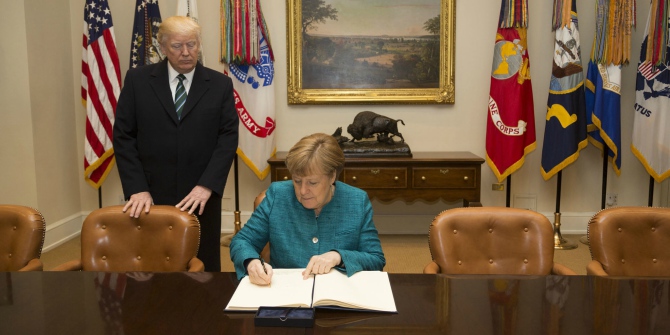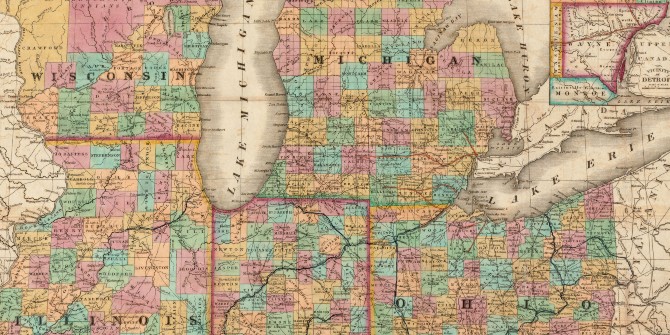 This week the Democratic Party held their online 2020 presidential nominating convention. Peter Finn writes that while history has been made with the nomination of Kamala Harris as Joe Biden’s running mate, the party’s alliance of convenience with Republican never-Trumpers could spell discord for the Democrats in the future.
This week the Democratic Party held their online 2020 presidential nominating convention. Peter Finn writes that while history has been made with the nomination of Kamala Harris as Joe Biden’s running mate, the party’s alliance of convenience with Republican never-Trumpers could spell discord for the Democrats in the future.
- This article is part of our Primary Primers series curated by Rob Ledger (Frankfurt Goethe University) and Peter Finn (Kingston University). Ahead of the 2020 election, this series explores key themes, ideas, concepts, procedures and events that shape, affect and define the US presidential primary process. If you are interested in contributing to the series contact Rob Ledger (ledger@em.uni-frankfurt.de) or Peter Finn (p.finn@kingston.ac.uk)
Held largely virtually, though formally based at the Wisconsin Center in Milwaukee, Wisconsin, the 2020 Democratic National Convention, which has officially seen Joe Biden and Kamala Harris adopted as the Presidential and Vice Presidential candidates, has been like none of its predecessors. Here are my key takeaways from this week’s convention:
Joe Biden is officially a presidential nominee: The former Vice President has been the presumptive nominee for months, officially becoming the nominee during a colourful virtual roll call on Tuesday night. In some ways the move from presumptive to official nominee is a distinction without a difference. Yet, to leave the characterisation at that would be shortsighted. Biden has run for president twice before (1988 & 2008). After dropping out of the 2008 contest, he went on to become Vice President to Barack Obama for eight years. Beyond this, he represented Delaware as a Senator from 1973 to 2009, with his past actions sometimes causing friction with, and points of attack for, younger or more progressive Democrats (including his now running mate, California Senator, Kamala Harris). If he loses in November, Biden will still have been one of the most important recent figures in US politics. If he wins, he will be heralded by the party faithful for ousting President Donald Trump, will have a chance to respond to the COVID-19 pandemic and will be a key actor in defining the future of both the Democratic Party and the US government.
Kamala Harris is making history: Likewise, Harris was anointed by Biden as his vice presidential pick earlier this month, with her confirmation on Wednesday evening little more than a procedural formality. However, this confirmation made history, with Harris becoming the first woman of colour to be chosen as a Vice-Presidential candidate. Moreover, as Amy Tatum recently noted in this series, ‘she is the first Asian American to be on a presidential ticket; and if elected would become the first woman to hold the office of Vice-President of the United States.’ These firsts could increase in the coming years. Biden has intimated he sees himself as a ‘bridge’ to a new generation of Democratic Party politicians, making it unlikely he will seek a second term if elected in November. As such, Harris could find herself in pole position to become the Democratic nominee to replace Biden as president in 2025.
Democratic Party has dealt well with switch to digital: Since the Spring, the Biden campaign has adopted a relatively restrained posture, shifting from face-to-face campaigning to a mix of online speeches, meetings, gatherings, the use of social media and dabbling with a podcast. This approach appears to have stood them in good stead for the convention, which has built on this foundation with a slick website, live and recorded contributions from across the party and a clear demonstration of big-tent unity.

“Vote for Joe Biden & Kamala Harris” by Rick Obst is licensed under CC BY 2.0
The Democratic Party is (currently) a home for Never-Trumpers: Republicans disillusioned by the direction of their party under Trump currently find a home in a Democratic Party focused on the singular task of removing the president from office. Groups such as the Lincoln Project are encouraging such voters to support Biden, with the convention featuring contributions from Republicans such as former Ohio Governor John Kasich and a video showcasing Biden’s friendship with John McCain. Whether this marriage of convenience between Never-Trumpers and the Democratic Party can last beyond November, or will dissipate after the presidential election, however, remains to be seen.
Four years after being president, Barack Obama remains a key figure: In his convention speech Barack Obama was explicit in his criticism of Trump, arguing, among other things, that his ‘administration has shown it will tear our democracy down if that’s what it takes for them to win’. This criticism, along with similar rebukes delivered by Michelle Obama, were key moments of the convention. Having explicit backing from the Obamas is clearly a boon for Biden. That said, one wonders whether such a heavy reliance on the couple could start to become as much of a distraction as a benefit for the Democratic Party if it continues in future.
The future direction of the Democratic Party is still unknown: Despite unity around the former president, there is significant division among Democrats. Indeed, rather than deal with the political and ideological divisions within the Democratic Party, the convention essentially parked them in favour of a concerted effort to boost Biden and dislodge Trump. However, these divisions are real and long-standing. The more progressive wing represented by New York Representative Alexandria Ocasio-Cortez and Independent Senator Bernie Sanders of Vermont, for example, have long chafed at the centrist instincts of party leaders. Moving forward, if the alliance with Never-Trumpers was to become a permanent fixture of the party then this schism would likely worsen. If Harris does run to be the party’s nominee for president in 2024, a challenge from the left could certainly materialise. Interestingly, Ocasio-Cortez will be 35 in October 2024, making her eligible to run for the White House. Though it is unlikely she could secure the nomination in four years. It is certainly within the realm of possibility she could act as a galvanising force similar to Sanders in 2016.
Please read our comments policy before commenting.
Note: This article gives the views of the author, and not the position of USApp– American Politics and Policy, nor of the London School of Economics.
Shortened URL for this post: https://bit.ly/3gf9kLD
About the author
 Peter Finn – Kingston University
Peter Finn – Kingston University
Dr Peter Finn is a multi-award-winning Senior Lecturer in Politics at Kingston University. His research is focused on conceptualising the ways that the US and the UK attempt to embed impunity for violations of international law into their national security operations. He is also interested in US politics more generally, with a particular focus on presidential power and elections. He has, among other places, been featured in The Guardian, The Conversation, Open Democracy and Critical Military Studies.







I’ve long been fascinated by the US system for electing a president, ever since experiencing the Republican National Convention while a student, in the US on holiday in 1980. It fascinated me that a long article in ‘Time’ magazine was devoted to whether or not candidate Reagan should end his acceptance speech with a prayer. I can’t remember the outcome (of the prayer debate) but the combination of intense scrutiny of what might be delivered, and concurrent management of the wider and future public implications, was gripping.
Watching the DNC this past week, what struck me was a sensation that while not entirely new, was certainly unexperienced over the past few years.. How reassuring it was to hear candidates talking about their formation as people, their principles, and saying supportive things about others.